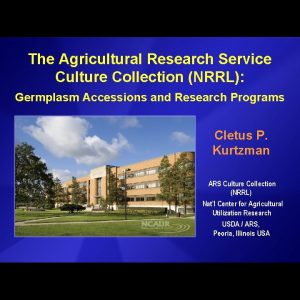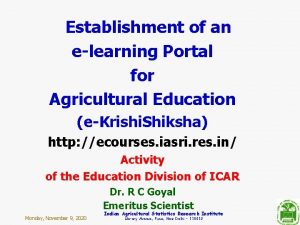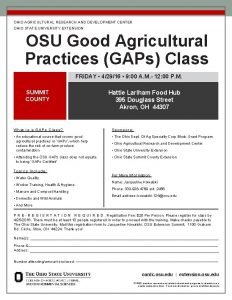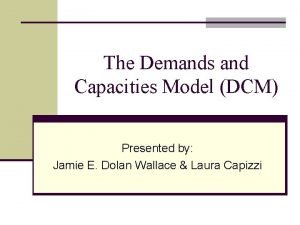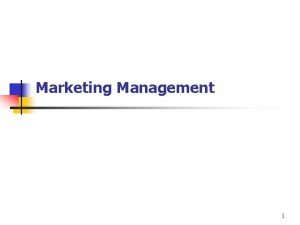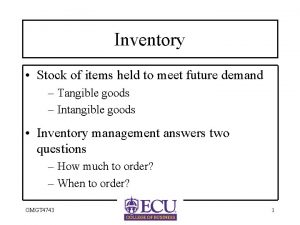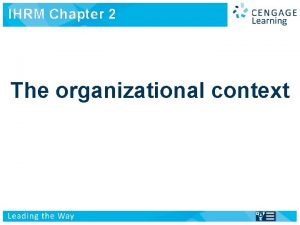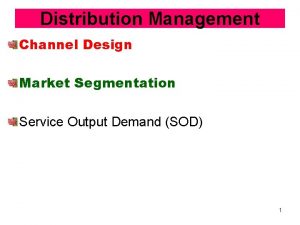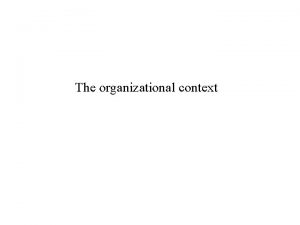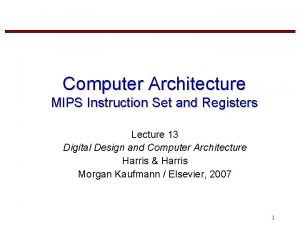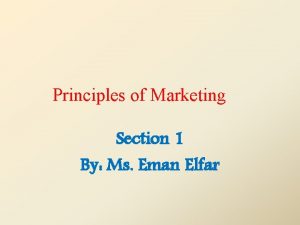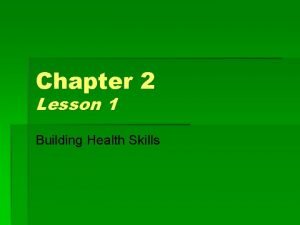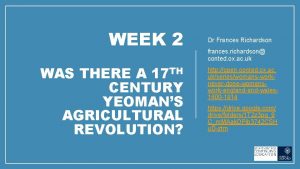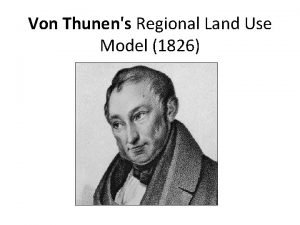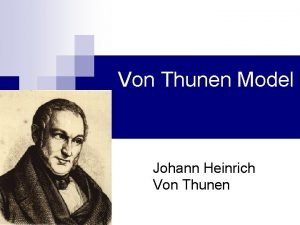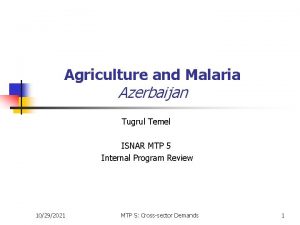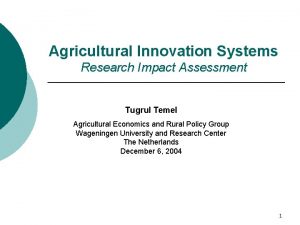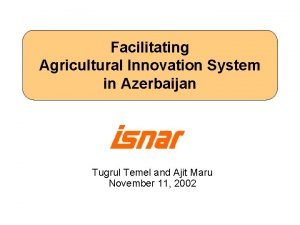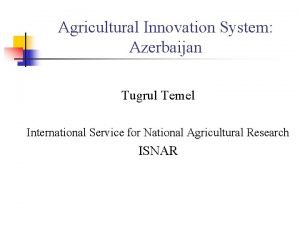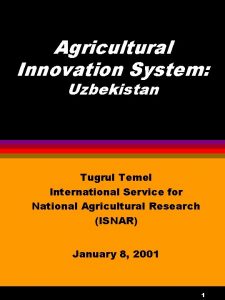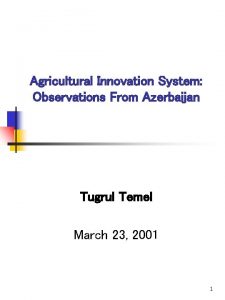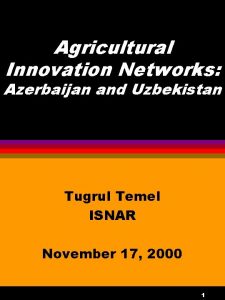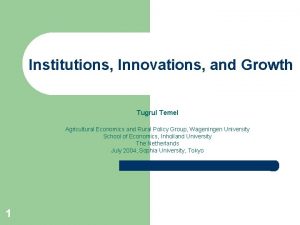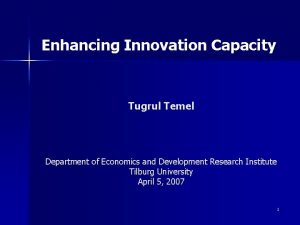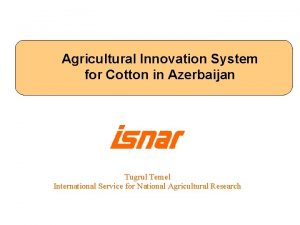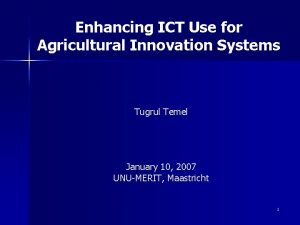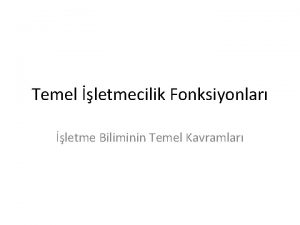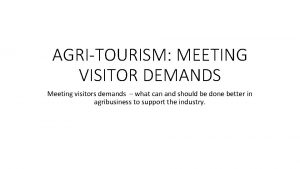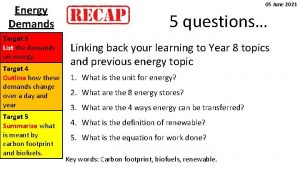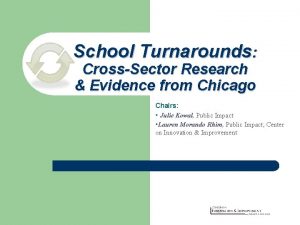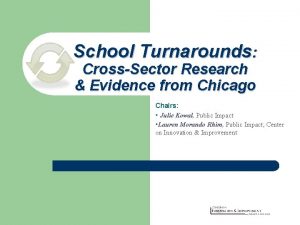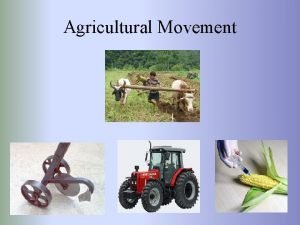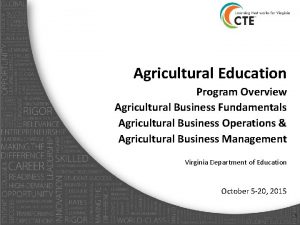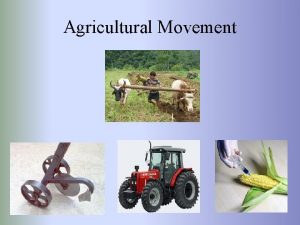CrossSector Demands on Agricultural Research Tugrul Temel ISNAR




















- Slides: 20

Cross-Sector Demands on Agricultural Research Tugrul Temel ISNAR MTP 5 EPMR Presentation February 28, 2002 EPMR/ 28 Feb 2002

Goal of project Strengthen capacity of research and development organizations to respond effectively to new demands for knowledge arising from social, economic, and environmental changes beyond those traditionally associated with agricultural production EPMR/ 28 Feb 2002 2

When is an issue cross-sectoral? When people in key institutions are having difficulty in dealing with a problem from their limited perspective and the problem is having important implications for human well-being EPMR/ 28 Feb 2002 3

Attributes of CS issues n Incentives to act in new ways increased by n n n Perceived urgency of threat to well-being Spatial extent and duration of threat Nature of response influenced by n n Complexity of threat (two-way links) Organizational similarity across sectors EPMR/ 28 Feb 2002 4

Guidelines for action Effective response to CSDs requires n Understanding – not just information n Monitoring/evaluating multiple effects n Novel and functional partnerships n Attending to the effect on innovation systems of large shocks EPMR/ 28 Feb 2002 5

Guidelines for action: What we draw on n n Methods to enhance understanding where business is no longer usual Integrating M&E in R&D processes Managing multi-institutional and disciplinary initiatives Methods to stimulate and assess innovation coming from multiple sources EPMR/ 28 Feb 2002 6

Scope: potential & feasible n Many possible and important areas n n Agriculture-health links Agricultural research & disaster recovery Food safety, and others Where we get involved decided by n n n Urgency and scale of impacts Our resources, capacities & history Chances of making a difference-with others EPMR/ 28 Feb 2002 7

Cross sector demands: expected outputs n n Enhanced capacity in key institutions manifest in better designed and executed policies and programs Findings conveyed in reports, radio scripts etc n n Various formats for different actors Making experience as direct as possible EPMR/ 28 Feb 2002 8

MTP 5: What are we doing and considering? n n HIV/AIDS, Food and Nutrition Security: Supporting innovation, E&S Africa 2000 Global Initiative on AIDS, Agriculture and Food Security (GIAAFS), 2001 – Agriculture and Malaria, 2000 Agricultural Research in Disaster Recovery EPMR/ 28 Feb 2002 9

HIV/AIDS and Agriculture: Why this multi-sector issue? n Incentives to act “outside the box” n n Wide and diverse impacts: Across regions Urgent: Impacts felt in villages & institutions Long lasting: Drugs and vaccines not enough Response is constrained by n n Poor understanding of the links & what to do Institutions themselves contribute to HIV spread & erode under AIDS’ impacts EPMR/ 28 Feb 2002 10

HIV/AIDS, food and nutrition security: supporting innovation Purpose: Prevent and mitigate AIDS’ impacts on rural livelihoods and food security Objectives: 1. Fill critical gaps in knowledge on agriculture AIDS links – both directions 2. Fill critical gaps on effects of current policies and programs 3. Enable organizations to act on realistic priorities, in partnership with communities EPMR/ 28 Feb 2002 11

Outputs for action Assessing policies & programs n n n Describe & make available an “AIDS lens” Estimate: +/-/0 for prevention/mitigation Follow some in field (rice M; new cassava var U) Conduct “program experiments” on some Assessing multiple effects by M&E n n E. g. Cassava processing for starch n n Are small rural enterprises profitable & competitive? Can young adults make a living that enables them to avoid risky situations? EPMR/ 28 Feb 2002 12

Outputs for action n Promote functional partnerships n n n Build on converging interests Let ethics and efficiency play role in site selection Enhancing innovation in stressed systems n n incentives for, identify and diffuse innovations in affected communities, i. e. , using rural radio Create opportunities for exchange among practitioners & stakeholders, i. e. , practitioner groups, fairs EPMR/ 28 Feb 2002 13

Agriculture and malaria n Azerbaijan: Roll Back Malaria n Malaria is positively correlated with n n irrigation water use soil salinity number of former state farms Role of institutions EPMR/ 28 Feb 2002 14

Need for n n Financial resources Capacity development in resource mngt n n Monitoring health in relation to agriculture n n n Irrigation water use and soil Community water authorities Water tables Changes in farming system Changes in crop patterns Cooperation: agriculture, env. , and health EPMR/ 28 Feb 2002 15

Future focus n ISNAR’s role in SIMA n n Diagnostic: Mapping regions at risk of high social and economic costs Institutional: identification of structural and process weaknesses in innovation system Policy: building commitment to cross-sector action Africa and Central Asia EPMR/ 28 Feb 2002 16

Role of research in disaster recovery n n n Disaster: a shock that overwhelms normal systems of prevention and preparedness Complex disasters: involve security and political objectives Climate change: increasing variability of weather and frequency of extreme events EPMR/ 28 Feb 2002 17

Role of research in disaster recovery n Research potentially brings: n n Knowledge: avoid mistakes, plan future Networks: national, international Management capacity Role cuts across all phases: n n n Emergency: information Recovery: appropriate seed, technology Reconstruction: R&D EPMR/ 28 Feb 2002 18

Role of research in disaster recovery n Why CGIAR: n n Networks hold knowledge Concern with vulnerability of different groups, role of women in resilience of society EPMR/ 28 Feb 2002 19

Conclusion n Broad mandate but limited resources: n n Search for support has to be strategic and focused to ensure each study contributes to understanding of processes at different levels Collaboration with other MTP Projects is essential EPMR/ 28 Feb 2002 20
 Agricultural research service culture collection
Agricultural research service culture collection E learning agriculture portal
E learning agriculture portal Ohio agricultural research and development center
Ohio agricultural research and development center Fitness chapter 6
Fitness chapter 6 Demands and capacities model
Demands and capacities model Needs wants and demands
Needs wants and demands Marketing management
Marketing management A stock of items held to meet future demands.
A stock of items held to meet future demands. Stages of internationalization in ihrm
Stages of internationalization in ihrm Don't delay dawns disarming display
Don't delay dawns disarming display Sadlier level g unit 12
Sadlier level g unit 12 Service output demands
Service output demands Paralinguistic demands
Paralinguistic demands Management demands of international growth
Management demands of international growth Mips instruction set architecture
Mips instruction set architecture When backed by buying power wants become
When backed by buying power wants become Two traits of a health literate person
Two traits of a health literate person The agricultural revolution
The agricultural revolution Von thunen model frq
Von thunen model frq Johann heinrich von thünen model
Johann heinrich von thünen model Paris basin rivers
Paris basin rivers
